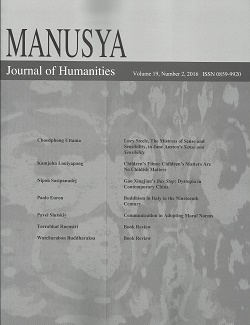Title : Children’s Films: Children’s Matters are No Childish Matters
Author(s) : Kamjohn Louiyapong
Pages : 17-48
Abstract in English : This paper studies Thai children’s films
produced in the appropriately five decades
since the decade of B.E. 2510 (1967). The
study reveals that, in this time, there have
been more than fifty Thai films in rich
diversity both produced “for” children
and “about” them, and that of these two
groups, the first is more likely to be
intended primarily for a young audience.
Thai children’s films can be divided into
five periods from a historical point of view,
and categorized into three groups, namely,
children and their inner lives, children and
the family and, children and society.
Despite this variety of children’s films,
there are some similarities in terms of the
art of children’s films, especially among
those in the category of children and
society. These films present children as
protagonists and adults as villains and
feature children’s struggles with the
support of certain adult characters,
including by means of weapons. Most take
place outside the children’s home. The
films are presented through the eyes of the
children with some implicit adult
worldview. The storytelling is simple and
the use of film language helps inspire
children’s imagination. There are also the
use of vivid colors, children’s songs or
music as well as the use of intertextuality
associating the films with children’s
literature and a social context.
Ultimately, children’s films have
contributed to the construction of
childhood representations, which can be
classified as positive, negative and
ambiguous. As for the positive
representation, children are presented as
decent, grateful, friendly and having a
fighting spirit. As for the negative one,
children are portrayed as child ghosts,
sinful children, problem children and
victims. In ambiguous representations,
children see ghosts. These images are
constructed under conflicting ideologies of
children, namely, children as activepassive
agents, an innocent-an evil, and
hybrids between good and bad. Moreover,
the ideologies of gender, class, friendship,
family, the triad Nation-Religion-
Monarchy as well as anti-capitalism have
also contributed to the diversity in
children's representations.


